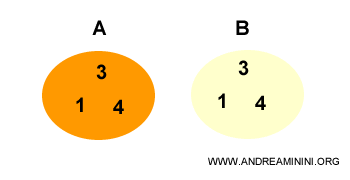Identical Sets
Two sets A and B are identical sets (equal sets) if they satisfy the condition of mutual inclusion $$ A \subseteq B \wedge B \subseteq A $$ In this case, it is written $$ A = B $$
In simpler terms, two sets A and B are identical if A includes B and B includes A.
Both sets are improper subsets of each other.

Proof
According to the first inclusion, all elements of set A belong to set B.
$$ A \subseteq B $$
Therefore, there are no elements in A that are not also contained in B.
According to the second inclusion, all elements of set B belong to set A.
$$ B \subseteq A $$
Thus, there are no elements in B that are not also contained in A.
If there are no elements in B not contained in A and no elements in A not contained in B, it is clear that the two sets are identical.
$$ A = B \Leftrightarrow A \subseteq B \wedge B \subseteq A $$
Alternatively, you could also say that two sets are equal when every element of A belongs to B and vice versa. $$ A = B \Leftrightarrow ( x \in A \Leftrightarrow x \in B ) $$
Example
I have two sets
$$ A = \{ 0, 1, 2, 3, 4 \} $$
$$ B = \{ x \in N \ | \ 2x + 1 < 10 \} $$
The second set B includes all natural numbers that meet the condition 2x+1<10.
$$ 2x+1<10 $$
$$ x < \frac{9}{2} $$
namely the natural numbers 0, 1, 2, 3, 4
$$ A = \{ 0, 1, 2, 3, 4 \} $$
$$ B = \{ 0, 1, 2, 3, 4 \} $$
As can be seen, both conditions of inclusion are satisfied
$$ A \subseteq B $$
$$ B \subseteq A $$
Therefore, the two sets are identical.
$$ A=B $$
Observations
A few notes on equal sets:
- Equal sets have identical cardinalities.
Although it may seem straightforward, it's useful to remember. Since equal sets A = B contain the same elements, they also share the same number of elements, i.e., they have identical cardinalities. $$ | A | = |B| $$
And so forth.
